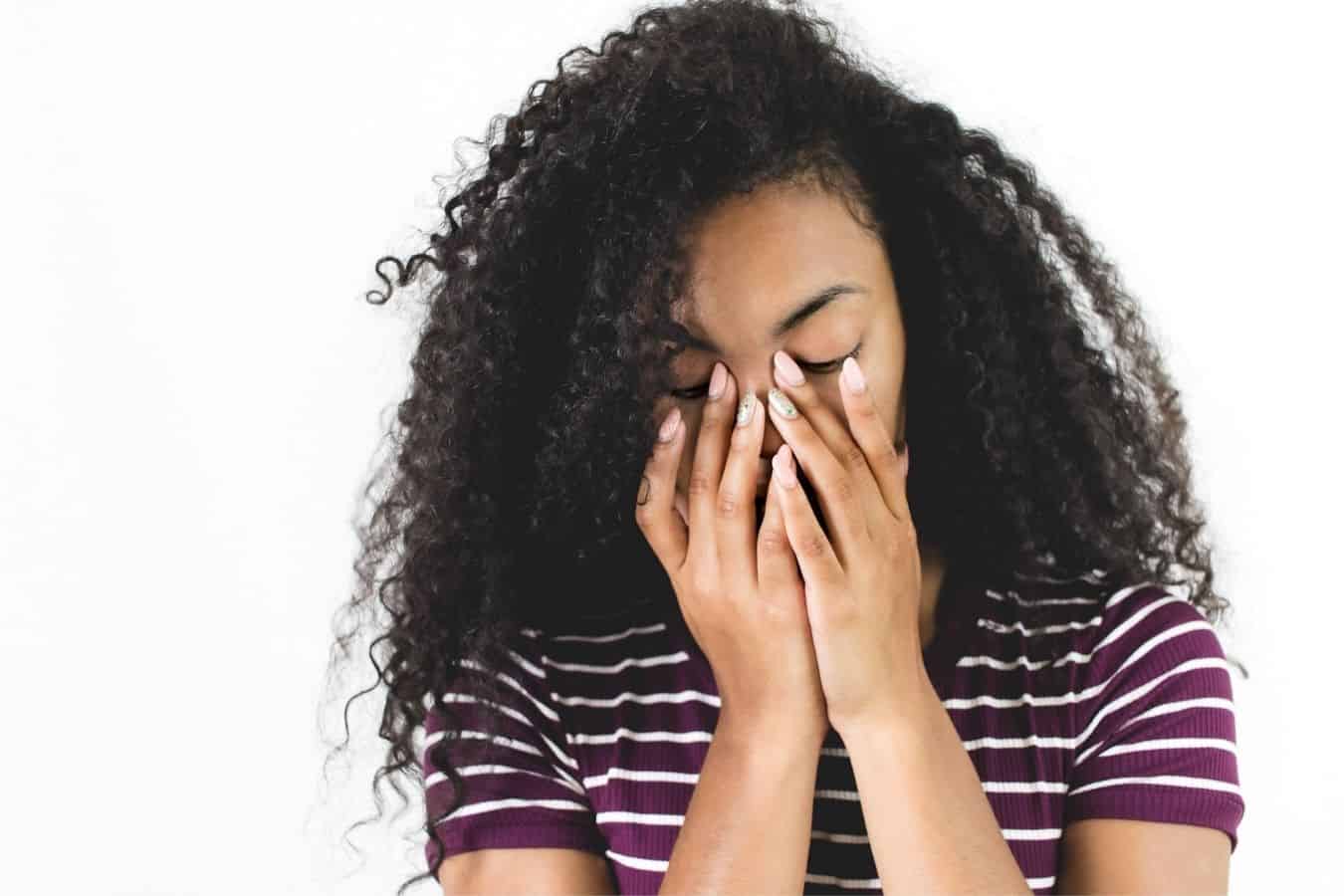Head lice are a nuisance, but they can be even more of a nuisance if your hair is thick and curly. Nit combing especially can be a nightmare for this hair type. In this article, we will take a look at the best methods to get rid of lice in thick, curly hair, as well as preventative measures you can take to keep lice out of your hair.

The best way to get rid of lice in thick, curly hair is thorough nit-combing when the hair is wet, parting up the hair into sections to facilitate the process. You can combine this process with chemicals or natural remedies such as ‘smothering’ the lice with an agent or using essential oils.
Why Do We Get Lice?
Head lice are tiny parasitic insects, about the size of sesame seeds, that live only in human hair.
They feed by sucking tiny amounts of blood from the scalp. They require a human host to provide nourishment so they can live and reproduce.
The female louse lays about eight eggs (also known as ‘nits’) a day and glues them to the hair shaft.
Nits take about a week to hatch. The young head lice, known as ‘nymphs’, become adults after a week.
Lice live for up to 30 days, provided they have a host.
Lice cannot jump or fly. They have very short legs with specialized claws for walking on human hair. They can move quickly through hair, but not on any other surface.
Lice are more common in children as they are spread through head-to-head contact during play.
Less commonly, they may spread via shared use of brushes or towels, wearing clothing worn by an infested person, or lying on a bed, couch, or carpet that has recently been in contact with an infested person.
What Are The Symptoms Of Lice?
The symptoms of head lice are the visible detection of lice and/or nits in the hair, and itchiness, tingling, and/or a crawling sensation on the scalp.
If you or your child has lice, you’ll see small brown insects the size of sesame seeds moving around, or the appearance of nits as small white objects stuck to hair shafts.
If you’re unsure whether you’re seeing dirt or lice and nits, dirt is easy to comb out, whereas lice and nits are difficult to comb out.
A secondary problem of having head lice is that sores on the scalp or bacterial infection may be caused by itching.
It’s important to note, however, that the lice themselves do not spread disease and cause minimal damage to the hair and scalp of the host.
They are more a nuisance than anything else but can be effectively eliminated by using the right methods.
Which Hair Is More Prone to Getting Lice – Curly or Straight?
Anyone can catch head lice, regardless of their hair type. Because it’s not actually the hair that head lice are attracted to, but the blood from your scalp.
That being said, there are a few factors with curly hair that means a lice infestation is less likely.
Curly hair tends to need washing less frequently than straight hair.
This is because sebum travels faster down the shaft of straight hair, meaning it tends to look and feel oily faster than curly hair does.
People with curly hair can go for longer without washing their hair. Because oil does not distribute as well through curly hair, curly hair can be prone to dryness.
As a result, people with curly hair are more likely to use styling products to add moisture to their hair and reduce frizz.
Lice actually survive better on clean hair with no products as it’s easier for them to climb on and reproduce.
Therefore, if you have oily hair or curly hair with products on, it will be harder for the lice to start an infestation.
Overall, curly hair is less likely to get a lice infestation than straight hair. But it still does happen, especially with children.
The main problem is that if you do get lice in thick curly hair, they can be a pain to get out, simply because such hair makes nit combing an arduous task.
Because it is more challenging to get rid of lice and nits in thick curly hair, lice infestations can become heavy quite quickly.
So it’s important to know how to deal with them if it happens.
How to Get Rid of Lice in Thick Curly Hair

Chemicals
Using chemical shampoos, either over the counter or prescribed by your doctor, can be a fast and effective way of removing lice from your hair.
However, the harsh chemicals contained in them can be potentially drying or damaging to thick curly hair. There are alternative methods that may be less damaging to your hair.
You will also have to comb out the nits using a special comb. It is best to do so while the hair is wet.
Smothering
Using a home remedy is probably preferable to putting harsh chemicals on your hair (or your child’s hair).
The idea of these home remedies is that they smother the lice, killing them and so making them easier to remove.
They also facilitate easier combing through the hair to get rid of the nits.
For the smothering method, you can use an agent such as:
- Olive oil
- Mayonnaise
- Vaseline
- Butter
Leave the product on your hair overnight. Then in the morning, you can comb out the dead lice and nits prior to shampooing.
Essential Oils
When combined with the combing method, some essential oils are effective at removing head lice.
Before using essential oils, always dilute with a carrier oil first and perform a patch test.
Oils that have shown to be effective for lice are:
- tea tree oil
- lavender oil
- peppermint oil
- eucalyptus oil
- neem oil
- clove oil
- aniseed oil
- cinnamon leaf oil
- red thyme oil
- nutmeg oil
To use, mix 2 ounces of olive oil with 15 to 20 drops of your chosen essential oil. Apply this mixture to the scalp and leave overnight. In the morning comb out the hair to remove lice and nits. Then shampoo and rinse out the hair.
Combing
The main and the best way to get rid of lice and nits in thick, curly hair is to use a special nit comb.
Don’t use it on dry hair, however, as it will get tangled up in your curls. It is best to nit comb while the hair is wet.
You can also use a detangler, clear conditioner, or oils to help facilitate the process.
Dividing the hair up into sections will also help to make sure you comb through the whole head of thick, curly hair thoroughly. To nit comb your hair or your child’s hair effectively:
1. Create 10 to 12 sections of hair across the head (5 or 6 sections on each side of a middle parting). Don’t bother detangling the hair at this point but just create each section as best you can and tie it up.
2. Take the first section and detangle it, then nit comb it thoroughly. As you go, clean the comb with white toilet paper or tissue so you can inspect anything on it then bin it.
3. Inspect the tissue for black or brown specks. If they are tear-drop shaped they are nits. The head lice will be tiny and have six legs. They are about the size of sesame seeds and can be pale or dark brown, depending on their age.
4. When you have finished a section of hair, re-bunch it and move on to the next. Complete all sections of the hair in this manner, detangling and combing them thoroughly.
5. Don’t rush this process as it’s important you do it properly. As soon as you touch your hair the lice will run away from your hand (they can move surprisingly quickly through human hair). Bunching up your hair in this manner helps contain that movement and makes them easier to remove.
It’s best to repeat this wet combing process every three to four days until it’s been two weeks since you’ve seen any nits or lice.
How To Protect Thick Curly Hair from Lice
It’s often said that prevention is better than cure and this is certainly true when it comes to keeping lice out of thick, curly hair. Below are some tips to keep the critters out of your curls:
- The best way to protect your thick, curly hair from lice is to keep it tied back, especially if your children have lice or you suspect they do. When checking children for lice, keep your own hair tied back so lice can’t get into it.
- Don’t let your children get into your bed until they are clear of lice.
- Wash bed linens, towels, and clothing in very hot water (at least 130°F/54°C), then tumble dry hot for 20 minutes.
- Vacuum your carpets and upholstered furniture if anyone in your household has head lice.
- Soak haircare products and items such as combs, headbands and ponytail holders in rubbing alcohol or medicated shampoo. They can also be washed in very hot water, such as in the dishwasher.
- Teach children to avoid head-to-head contact with others, and avoid touching or playing with other children’s hair.
- Teach children to avoid sharing personal items such as brushes and combs, hats, scarves and jackets.
- Check children regularly. If lice have been reported at their daycare centre or school, check every three to four days. Dealing with lice in the early stages is much easier.
Disclaimer: This site is not intended to provide professional or medical advice. All of the content on LovedByCurls.com is for informational purposes only. All advice should be followed at your own discretion. Ingredients may change at any time so always check the product label before using. Check our full disclaimer policy here.
